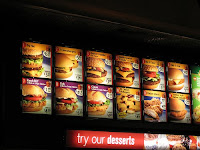
I think you'd be hard pressed to find a person today who could not "read" this image. Its structure is simple. Its meaning, undeniable.
This image tells us something.
This image is telling us, quite clearly, what is permissible and what is not. Furthermore, assuming that we are people who tend to follow the established rules, this image will is also telling us how to act.
I hold that this image is as affective, if not more affective, than a sign that reads: "No Cell Phones."
Now, like Elkins, I think we all "hope that images are not a language, and pictures are not writing" (128). But when confronted with the abundance of expressive images we see today, and the move towards using images to convey thought, it's hard to deny the possibility that one day our hope may only exist as a dusty old photograph.
Of course, by the dictionary definition (well, at least according to the dictionary definition found on my MacBook) images will never be a language, for language is a, "method of human communication, either spoken or written, consisting of the use of words in a structured and conventional way."
Case closed. Hope saved.
But, weren't hieroglyphics also a language, primitive as it may have been? And wasn't that system just a system of symbolic images? (This was astutely detailed in a presentation on the last day of class, so I won't go any further. But you get the point...)
Elkins can hope and pray all he wants. It's still possible that language is de-voloving.
If you want proof, go to any Fast Food restaurant and see how much reading of words you have to do to order your food.

It's all just images and numbers.
But what about something a little more sophisticated than food?
What about for conveying information that will helps save lives?

Even the manuals giving directions on how to open the
emergency door in case of a plane crash are given entirely in
images!
So, maybe literacy is de-volving into something simple.
Something image-based. And maybe it's not. Instead of
answering this question (because there is no easy answer)
let us look at something a bit different. Let us look at the
visual literacy of the youth.
In an attempt to analyze visual literacy, I'd like to use an
example of a sign I saw at Columbia's Butler Library a
couple weeks ago. In the library, next to the circulation
desk, there is a sign that says, essentially, no cell phones at
the circulation desk. But instead of the phrase,
"cell phones" there is an image. And as you may
have guessed, the image used is that of a cellular device.
What you may not have guessed is that the image used in
lieu of "cell phone" is a very specific type of cellular device.
It is a smart phone.
(If you don't know the difference between a smart phone
and a cell phone, ask any teenager. They will all know the
difference between the two because they will have seen the
difference advertised ad infinitum on subway posters, on tv, in
magazines, etc.)
Though the term "cell phone" is an umbrella term which
includes "smart phone,"there is certainly a difference between
the two.
So, while the sign at Butler may mean to say, "No Cell
Phones at the Circulation desk,"what it is actually, more
accurately, stating is, "No Smart Phones at the Circulation desk."
And because the technology imbedded inside a smart phone
is different than that of a regular cell phone, it is not
unreasonable to image a scenario in which cell phones would
be okay, but smart phones would not.
Given that, it is possible that someone, like an adolescent
subway goer, who is well versed in advertising will read
the poster more accurately than, say, the individual
employed by Columbia University who created the sign.
My point: visual literacy develops in youth "naturally"
through interaction with visual media, namely the internet
and advertising. Which is to say, people learn visual literacy
much the same way they learn regular literacy, by interacting
with their environment. There is noneed to teach visual literacy.
Remember, though: visual literacy in no way suggests
an aesthetic appreciation! That is a topic for another post.

No comments:
Post a Comment